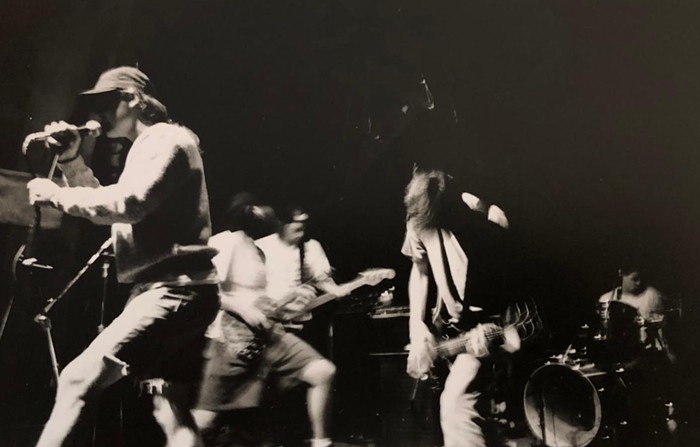"This is obviously one man's thing here, and it's very unusual," says Seattle musician/producer Steve Fisk during a recent visit to legendary audio engineer Kearney Barton's University District house and studio. This could qualify as understatement of the year.
Approximately 7,000 audiotapes sit in precariously stacked boxes in Barton's house—and that's after several excavating and purging sessions. For the past year or so, while the 79-year-old Barton has resided in Columbia Lutheran nursing home, his niece Patti Maltsberger and staffers from University of Washington Libraries and Light in the Attic Records (LITA) have been sifting through and removing literally tons of recordings and audio equipment from the man's home and studio—as well as 6,000 pounds of garbage. A pool table nobody knew existed was found buried under mounds of tapes and detritus. Relatives were surprised to find in one room a door that had been obscured for decades. Those who witnessed the epic removal efforts liken the scene to something out of Hoarders—except the inhabitant happens to be one of the most revered studio wizards on the West Coast.
A key architect of the Pacific Northwest sound over the last 50-plus years, the legendary Seattle recording engineer fell into poor health in 2007. After undergoing knee surgery that year, Barton contracted pneumonia and a blood infection, from which he's never really recovered. At Columbia Lutheran, Barton, lying on his side, his hands shaking, and admittedly feeling "crappy," answered some questions, often recalling events from over 40 years ago in staggering detail. "I've been credited with originating the Northwest sound, whatever that is," he states. "I really drove the tape recorders, so I got a lot of punch and presence. It had an intensity that you didn't have on a lot of records. I was one of the first [engineers] to emphasize drum tuning. Tuning the heads of the drums made a big difference. It eliminated the splatter that muddied up the sound."
"Mentally, he's as sharp as a whistle, but his body's just given up," Maltsberger laments, as we stand in the cluttered space adjacent to Barton's studio. "He's got congestive heart failure. He's gone to the hospital six times since December for critical-care-type things. He has tremors. He's shaking so bad now he can't walk independently."
A recent visit to Barton's homestead with veteran musicians/producers Fisk (keyboardist for Pigeonhed) and Pat Thomas (drummer for Mushroom, A&R consultant for LITA) found them roaming the premises—now relatively organized after existing in chaotic squalor for decades—with uncontainable glee, even though they've probably spent more collective hours over hot consoles than you've been alive. Both enthused over Barton's panoply of analog gear—the custom- made Langevin mixing board (sold for $13,000), Ampex reel-to-reel tape machines, an Electro-Voice 666 mic, Voice of the Theater and Altex monitors, a piano from the 19th century, and a vinyl-cutting lathe—as if they were ogling relics in a museum... which, in a sense, they were. (Barton's vaunted collection of 16 Neumann microphones had already been removed from the studio and are selling for $15,000 each, according to Maltsberger. Money earned from these sales goes toward Barton's health care.)
All of this equipment—including a forlorn-looking mic stand draped and entangled with moldering, busted headphones—will need to leave by March 31, which is when the house will be sold. Maltsberger and LITA are hoping that a philanthropist or two will offer to store the remaining tapes from Barton's vast archives. LITA has taken a few thousand tapes to its warehouse, and UW Libraries, spearheaded by John Vallier, has accepted 1,300 more from the 1950s through the '70s. Vallier and company are cleaning and digitizing them for educational purposes—and, potentially, commercial releases through LITA. (Paul Allen's American Music Partnership of Seattle donated $10,000 to UW Libraries to aid in this project.)
Vallier lists some of the unearthed treasures: the "serious psychedelic soul" of the Ron Buford Band, recorded for Quincy Jones's Gula Matari Records in 1968; several tapes of jangly, late-'60s pop from Heart's Ann Wilson and the Daybreaks; Sitar International's "Hindustani music goes pop"; plus material from the Sonics, Black on White Affair, Cal Tjader, the Kingsmen, and many more. LITA co-owner Matt Sullivan adds that he's excited by "a sitar session from '68 by Prabha Devi [and] some Quincy Jones–related tracks, and the thing we're most drooling over are a handful of tapes by local singer Woody Carr."
That interesting litany hints at Barton's versatility and open-mindedness. LITA's Sullivan came to know Barton in 2003 when the label was gathering songs for its celebrated Wheedle's Groove compilation; it ended up licensing songs by Black on White Affair and Soul Swingers, which Barton had issued on his Topaz label. "I soon visited the studio, and things were never the same," Sullivan remembers. "It was like meeting your sweet old grandfather submerged in an episode of Hoarders."
Sullivan—who swears that Barton can still reel off the details for every tape he produced—describes the qualities that made him such an in-demand studio engineer and crucial figure in Northwest music history. "The man has impeccable ears, and he's tenacious to find the right sound. He's also incredibly patient, humble, and makes you feel instantly at home, which is essential in what he does. Also, I don't believe he ever turned anyone down who wanted to record, if he had the time and availability.
"[Barton] recorded every genre—high school jazz bands, psych rock, country, soul, operas, classical, radio jingles, jazz, funk, singer-songwriters," Sullivan continues. "Amazing to think he was doing this [since] 1958. One of Kearney's first studios was on Fifth Avenue. He watched the Space Needle being built for the 1962 World's Fair right outside his studio window."
Barton's outstanding sonic accomplishments occurred in what could charitably be called less-than-salubrious conditions. His workaholic tendencies and personality quirks apparently left little time or inclination for niceties like cleaning or garbage disposal.
Thomas relates, "Every room [in the house's upstairs] was floor-to-ceiling tapes. Kearney was the kind of guy who, when he was done with a toilet paper roll, would just toss it in the room. So there were, like, 400 toilet paper rolls scattered about. [People cleaning up the house] had to wear face masks and rubber gloves; there was a one-inch layer of rat shit on everything."
"This is total Stephen King shit," Fisk says. "Matt said there'd be a plate of rice with a fork on it that looked like it had been there 14 years."
While the rest of his living quarters entered advanced stages of rot, Barton's studio remained an analog-appointed paradise that hosted a vast array of talented musicians. Most of the revered tools of Barton's trade now are the responsibility of friend Dave Cooley. The LA-based producer and mastering engineer is charged with the task of selling Barton's valuable gear, most of which has sold to high-level music-biz figures (sadly, Cooley wouldn't reveal their names).
"Kearney had the mother lode of vintage recording equipment... the best condenser mics, tape machines, and outboard of that era," Cooley says. (Hold tight: This next bit gets really geeky.) "Microphones like Neumann U47s—the kind used by the Beatles, Nat King Cole, and Sinatra—Neumann M49s, and U67s were plentiful. It's taking forever to go through them all and fix them up for sale. He also had some very rare tape machines like the Ampex MR-70, and some great-sounding workhorse machines like an eight-track Scully—also one of the cleanest Ampex 351 tape machines I've ever seen. It looked like it had been plated in brand-new chrome and brushed aluminum—[it] probably looked the same as the brand-new one Sam Phillips ordered [for Sun Studio] back in the '50s."
Cooley's initial visit to Barton Estates shocked him. "When we first saw the gear in his studio, it was beyond chaotic... just creative madness, a total mess. But Kearney knew his equipment and never felt the need to 'upgrade' to digital ADATs, Pro Tools, Apple computers, or fancy new speakers... which of course never sounded half as good as the vintage gems he had. He was a Luddite in the best possible way." ![]()




















